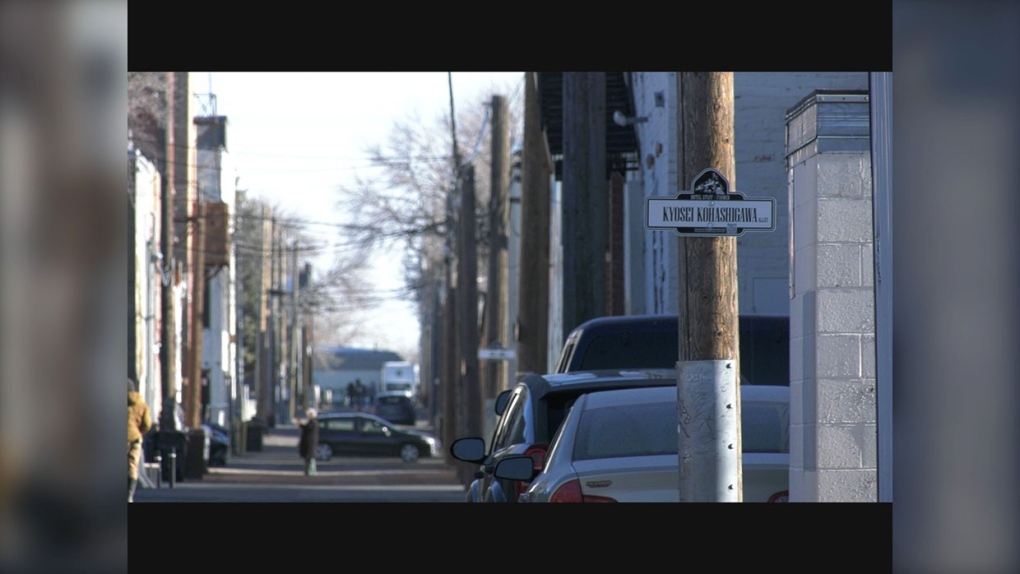Downtown back alley naming project helping share stories of ordinary residents who shaped Lethbridge
They may be the path less travelled, but a new naming project is hoping to draw more people to the back alleys of downtown, while providing a history lesson.
The Lethbridge Historical Society (LHS) launched its new Back Alley Naming Project to share the stories of ordinary residents who helped shape Lethbridge.
“Everything from the first health inspector, to the first person ever arrested and put into the provincial jail here to, housekeepers and anyone you could imagine,” said Belinda Crowson, president of the LHS.
Crowson says the streets of Lethbridge were named after the wealthy people during settlement in 1885. But most of them didn’t actually live in the city. She says the goal of the naming initiative is to showcase the people who make Lethbridge what it is.
“Ten years ago, I knew about an old plan on the city books to actually use the back alleys and try to encourage businesses to have entrances to the back alleys so historic buildings could have a front business and a back business and make better use of it,” Crowson explained.
More than 30 signs are set up around the downtown with a QR code on each for residents to learn about the story of that person.
“History goes into the institutions once we're no longer actively using it - we're done with an object it goes into the museum, etc.,” she said.
 Although the creation of the project didn’t involve the Galt Museum and Archives, staff are excited to see it take place outside museum walls.
Although the creation of the project didn’t involve the Galt Museum and Archives, staff are excited to see it take place outside museum walls.
“But, when it's alive, it's a part of the community and that's what these public history and public spaces projects are around, is keeping that in our mind and having people know we have a very interesting and diverse history here in Lethbridge.”
Although the creation of the project didn’t involve the Galt Museum and Archives, staff are excited to see it take place outside museum walls.
“Those kinds of creative projects are wonderful to have,” said Andrew Chernevych, an archivist with the Galt Museum. “They usually become starting points for artistic projects in the community, for research projects and they're connected to various anniversaries.”
“Streets in Lethbridge were named until 1910,” he said. “That’s when they were changed over to numbers, so it’s great to see these names coming forward to share with the public.”
CONNECT PEOPLE TO CITY
Crowson hopes the project will help connect people to the city's history and make them proud to see their occupation represented.
“We have a police officer and a firefighter and different groups like that,” Crowson said.
“The back alley sign for John T J Vallance - the first health inspector - is actually behind the Shanghai Chophouse and when he would've been working down here it would've been a butcher shop so it absolutely would've been a building he would've been in as a health inspector so having it linked there was vital.”
A guided tour will be taking place in May, with a hope to grow the project to more areas across the city.
“There’s so many ways we can use this type of idea to honour different groups and I would love to see where the idea goes from here,” Crowson said.
CTVNews.ca Top Stories

Prime Minister Trudeau meets Donald Trump at Mar-a-Lago
Prime Minister Justin Trudeau landed in West Palm Beach, Fla., on Friday evening to meet with U.S.-president elect Donald Trump at Mar-a-Lago, sources confirm to CTV News.
'Mayday! Mayday! Mayday!': Details emerge in Boeing 737 incident at Montreal airport
New details suggest that there were communication issues between the pilots of a charter flight and the control tower at Montreal's Mirabel airport when a Boeing 737 made an emergency landing on Wednesday.
Hit man offered $100,000 to kill Montreal crime reporter covering his trial
Political leaders and press freedom groups on Friday were left shell-shocked after Montreal news outlet La Presse revealed that a hit man had offered $100,000 to have one of its crime reporters assassinated.
Questrade lays off undisclosed number of employees
Questrade Financial Group Inc. says it has laid off an undisclosed number of employees to better fit its business strategy.
Cucumbers sold in Ontario, other provinces recalled over possible salmonella contamination
A U.S. company is recalling cucumbers sold in Ontario and other Canadian provinces due to possible salmonella contamination.
Billboard apologizes to Taylor Swift for video snafu
Billboard put together a video of some of Swift's achievements and used a clip from Kanye West's music video for the song 'Famous.'
Musk joins Trump and family for Thanksgiving at Mar-a-Lago
Elon Musk had a seat at the family table for Thanksgiving dinner at Mar-a-Lago, joining President-elect Donald Trump, Melania Trump and their 18-year-old son.
John Herdman resigns as head coach of Toronto FC
John Herdman, embroiled in the drone-spying scandal that has dogged Canada Soccer, has resigned as coach of Toronto FC.
Weekend weather: Parts of Canada could see up to 50 centimetres of snow, wind chills of -40
Winter is less than a month away, but parts of Canada are already projected to see winter-like weather.

































